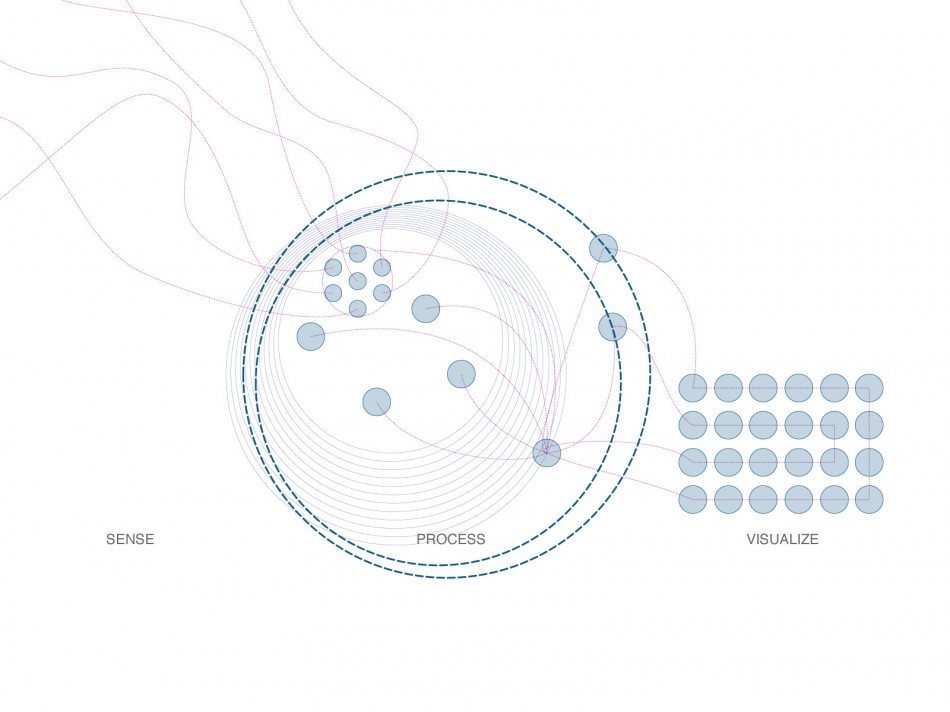Reactscape device:space
Responsive Systems
Landscape Architecture Advanced Topic Studio, ARCH 5002 Architectural Design Concentration
Fall 2011
Faculty
- Bradley Cantrell . Associate Professor of Landscape Architecture
- Frank Melendez . Assistant Professor of Architecture
{Syllabus}
Overview
Advances in technology have drastically altered traditional methods of analysis, construction, representation, and collaboration. Architects, landscape architects and designers address temporal landscape and dynamic architectural elements through biological and computational devices that are responsive to humans and ephemeral environmental stimuli. The paradigm shift in architectural and environmental design from the static to the dynamic requires designers to understand how responsive objects and systems function within larger ecological fields. This advanced topic studio explores the role of the designer and their ability to develop responsive architectural and landscape systems.
Students will be asked to research sensing devices, diagram and map site related and real-time data, develop working prototypes, develop case studies, research nascent technologies and propose speculative architectural and landscape scenarios. The studio will engage a range of sites throughout Louisiana, including the rural landscape of the Atchafalaya Basin and the urban setting of New Orleans, with each design team focusing a specific site. Students will be challenged to speculate on how new responsive interventions could be used to enhance and reinvigorate the sites. The studio will entertain a broad range of approaches organized around concepts of emergence, object orientation, self-organization, and cultural/social expression.
The studio will be divided into two phases. Phase 01 will begin by engaging the students in the 4th Advanced Architecture Competition: City Sense. The competition asks students to generate ideas, proposals, and visions of possible scenarios for a self sustaining city or building. The competition calls for entries that research and demonstrate the impact that real-time data collection might have on sensor-driven habitats and cities.
Students will continue to develop their proposals in Phase 02 of the semester. Participating in digitally focused workshops, students will be expected to continue to advance their design and computational skills by completing a series of tutorials that apply this knowledge to their projects. Responsive and interactive components and prototypes will be developed through digital and physical models. Employing a bottom-up approach to design, these components and prototypes will be developed into architectural and landscape systems. It will be up to each team to determine the exact scale, scope, and programmatic implications of the project.
Interdisciplinary Collaboration
“In the highly digitized age of the 21st century, architecture has become so thoroughly enmeshed within a network of other disciplines that what we are witnessing are new hybrid, mutant forms of practice that serve to reinvent the discourse of architecture as we know it. ” – Neil Leach . AD: Digital Cities
The studio will operate as a joint studio between landscape architecture and architecture. The studio is intended to foster an interdisciplinary design environment that seeks and promotes innovation and the generation of new ideas. Students will work in interdisciplinary teams during the various research and design phases of the project, working collaboratively in the same studio environment for the duration of the semester.

Studio Objectives
- To identify and research sensing devices and classify the various information, data, and phenomena that that they are capable of capturing and recording. To speculate and demonstrate how this information can be implemented to affect architectural and landscape ecologies.
- To identify and research the theoretical, conceptual and pragmatic applications of data-driven, interactive and responsive systems and their potential impact on the design of architectural and landscape systems.
- To compare and distinguish the difference between top-down and bottom-up approaches to design. To formulate and design a bottom-up system which demonstrates self-organizing and performative attributes. To describe how this approach to design affects the design process, workflow, and outcome of an architectural and landscape system.
- To recognize and differentiate the potential applications for digital design procedures and their integration into the design process and design project.
- To utilize time as a design attribute.
- To design and develop architecture and landscape architecture projects that are systematic, performative and responsive to the environment and context of Louisiana.
Studio Outcomes
- Students will understand potential applications for sensor driven devices and digital technology to impact and enhance architecture and landscape environments.
- Students will develop a series of working prototypes that demonstrate interactive relationships and responsive behaviors
- Students will generate digital and physical models that explore the proliferation of their prototypes into performative and responsive architectural and landscape system situated within a specific contextual condition.
- Students will be able to define parametric and algorithmic processes and explain how these processes are incorporated and integral to their design projects.
- Students will generate time based representations to communicate analytical and visual information pertaining to their architectural and landscape designs.
Schedule
One Response to Responsive Systems
Leave a Reply
You must be logged in to post a comment.

Pingback: Reactscape » Archive » Responsive Systems Studio Fall 2011